Ficus benjamina is an elegant tropical tree native to Asia and Australia. In nature it can grow upwards of 100 feet tall.
It naturalizes easily in tropical climates and sometimes is invasive as a landscape tree. The Benjamin Fig has large roots that can cause trouble in city yards and street landscapes.
If you live in a tropical climate zone of 9 to 11, you may prefer to grow it as a patio container tree so the roots and size are more easily contained.
The Ficus tree has long been a popular choice for growing as an indoor tree. In any climate its a good choice for a large showy elegant tree in large indoor spaces.
The Benjamin fig is easy to care for, tolerates less than ideal conditions, and can be easily pruned and propagated.
You have probably seen these attractive bushes in public buildings, tropical landscapes and private residences for decades.
This indoor tree is a tried and true choice for commercial use in hallways, foyers and offices.
The gracefully drooping branches with small glossy leaves create an eye catching burst of color and life wherever you put it. Just find it a good placement and leave it alone.
Read our printable care guide to learn how to care for your ficus tree.
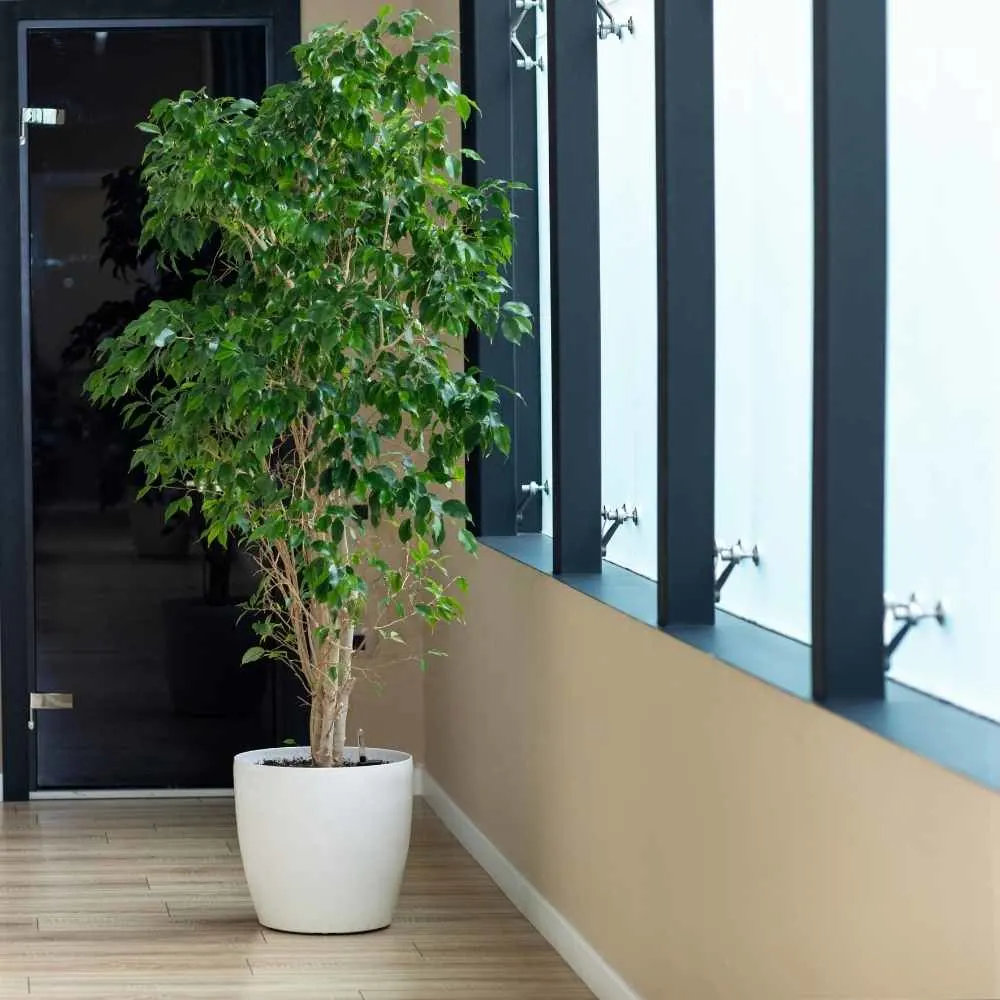
Ficus Varieties:
Your easy care weeping fig tree will give you years and years of lively growth.
Several cultivars of weeping fig plants are available. Both in solid Green and in variegated forms. Including the very interesting Ficus Triangularis which has very attractive triangular shaped leaves.
You can see The Ficus Triangularis at the TropicalplantsFL etsy shop. It’s a stunner!
Ficus Benjamina trees are sometimes sold with braided trunks like the money tree. This is an attractive look for the weeping fig.
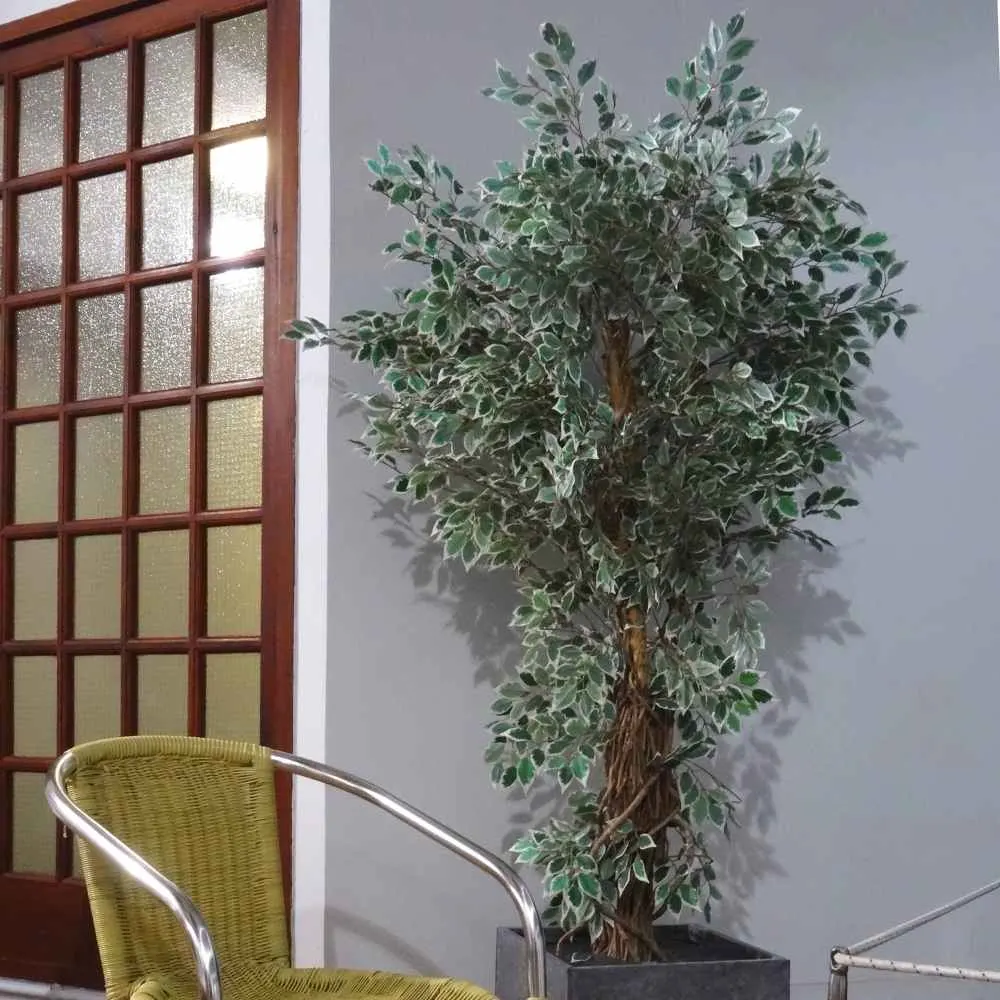
Ficus trees do remove formaldehyde from the air. This is useful in homes since home furnishings contain formaldehyde that reduces our home air quality.
Toxic Allergy Warning:
The Benjamin fig is one of the indoor trees that may cause allergic reactions. This is especially true for people with latex allergies.
The plant parts and sap are very irritating if ingested. Although the fruits (rarely seen indoors) are actually edible.
It is best to place the weeping fig in larger indoor spaces and keep it away from pets and children.
Ficus Benjamin Care Guide:
Ficus Benjamina Care
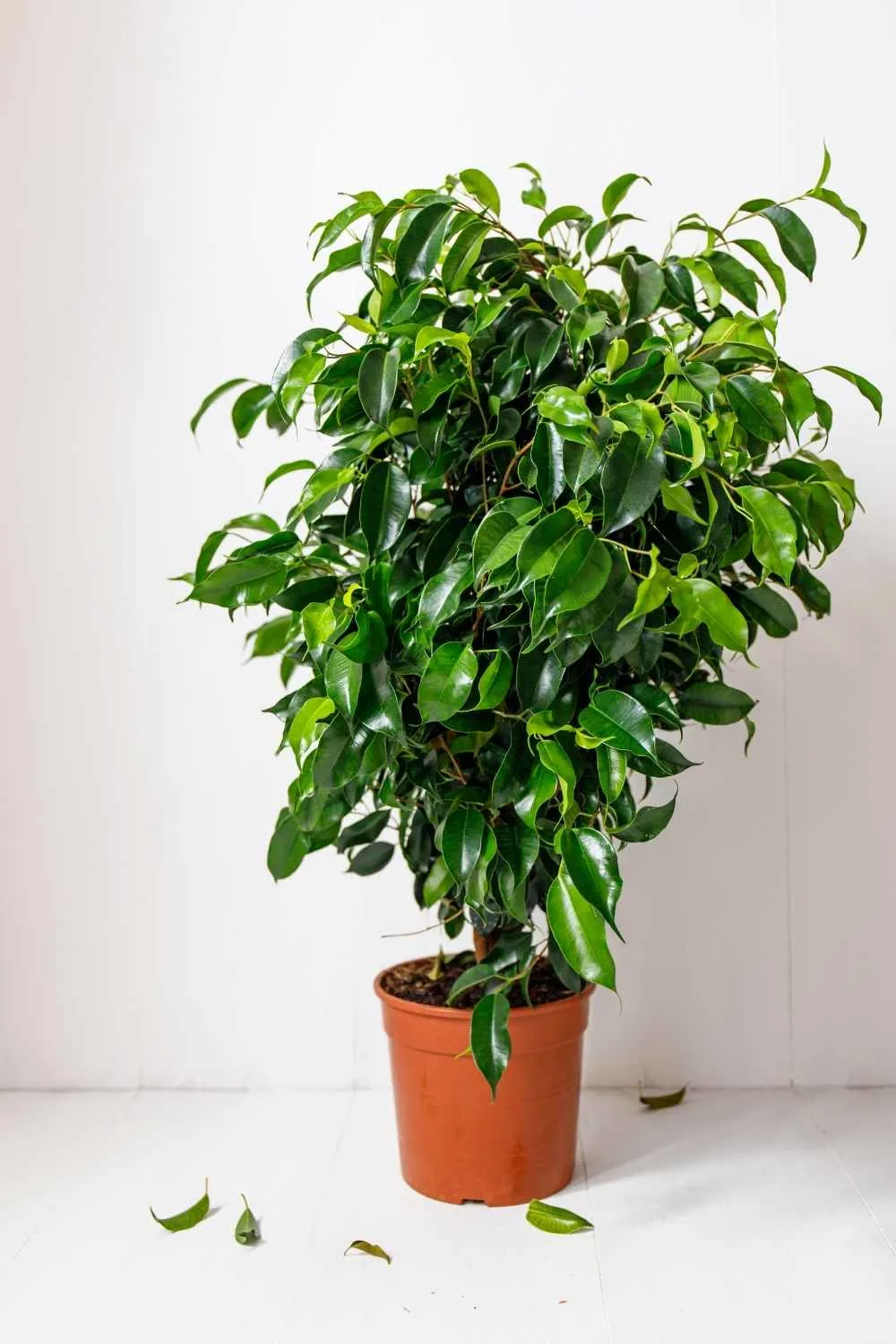
Ficus Benjamina tree Is a popular houseplant that grows as an indoor tree . This plant has beautiful glossy green or variegated leaves.
The weeping fig grows up to the ceiling if left unpruned. It's graceful foliage drapes from curving branches off the main trunk.
The weeping fig will grow 10 to 12 feet tall (or more) indoors.
Materials
Tools
Instructions
Soil Preference:
- The ficus tree requires a light well draining soil.
- A mix of potting soil and perlite will keep the roots happiest. Or try using a 100% cactus soil mix.
- The regular soil/perlite mix is 40% potting mix to 60% perlite.
- A heavy soil potting mix is not recommended for Ficus plants.
Pot Size and repotting:
- Weeping figs need to be planted in pots that fit the root size. To contain growth use a small pot that barely fits the root ball.
- Any well draining pot can be used. It MUST have drainage.
- Repot every second year or when roots come out the drainage holes on the pot bottom To the next pot size up.
- When repotting always choose a pot that is 2-3 inches larger in diameter than the previous pot.
Lighting:
- Benjamin fig plants require 6-8 hours of bright indirect sunlight everyday for optimal growth.
- It will tolerate lower light but the plant will drop a lot of leaves, get leggy sparse branches and loose color vibrancy.
- North or East facing sunny windows are best for this plant. A west or south window can burn the leaves.
Watering:
- Use distilled or filtered water or let your tap water sit at least 24 hours to neutralize harmful chemicals before watering your plants.
- Water your Ficus Benjamina when the soil is dry down an inch or so.Weeping fig plants enjoy moist not WET soil.
- Watering is best done on a regular schedule (try weekly) so the plant is not over or under watered. Both can cause stress on the plant.
- This plant enjoys humidity. In dry climates weeping figs will thrive with a humidifier nearby. Or put it in your kitchen or bathroom if you have adequate light and floor space.
- In dormant winter months reduce watering as the plant will not need as much.
- Never let this plant get wet feet. If the soil is compacted the bottom of the soil can remain wet. This encourages root rot and fungus gnats.
- If you see yellow leaves on your ficus tree you are probably overwatering or the soil is too heavy.
- If the tips of the leaves turn brown suspect Underwatering. Or too dry air.
Humidity Tips:
- This plant likes a humid environment. Mimic the conditions that it came from. Keep it around 40 to 60% humidity. If you find your plant needs a bit more humidity than your home provides...
- Add a humidifier close by the plant.
- Pebble trays also work great to help increase humidity around your plant as evaporation occurs.
- Grouping plants close together also helps them pick up humidity from each other as they respire.
How to Fertilize:
- Apply a good quality fertilizer (linked in materials) once or twice a month during growing season. This plant requires fertilizer to maintain the large green leaves.
- Decrease feedings by late Fall and allow plant to rest through the winter months.
- Look for brown spots on the leaves of your plants. This may indicate an over concentration of salts in the roots from over feeding. It can burn the leaves.
Temperature:
- Keep Weeping fig plants at a low of 60 Degrees F. to upward of 85 Degrees F. It enjoys consistent temperatures along with warmth and humidity.
- AVOID cold or hot drafts from heat vents, air conditioning or cold open windows.
Pruning:
- If your Ficus tree is too tall or leggy for your home you can prune it.
- Cut the stem between two nodes with sharp, sterile pruners.
- You can lightly prune back your ficus offshoots to keep the plant at your preferred height and bushiness.
Leaf Care: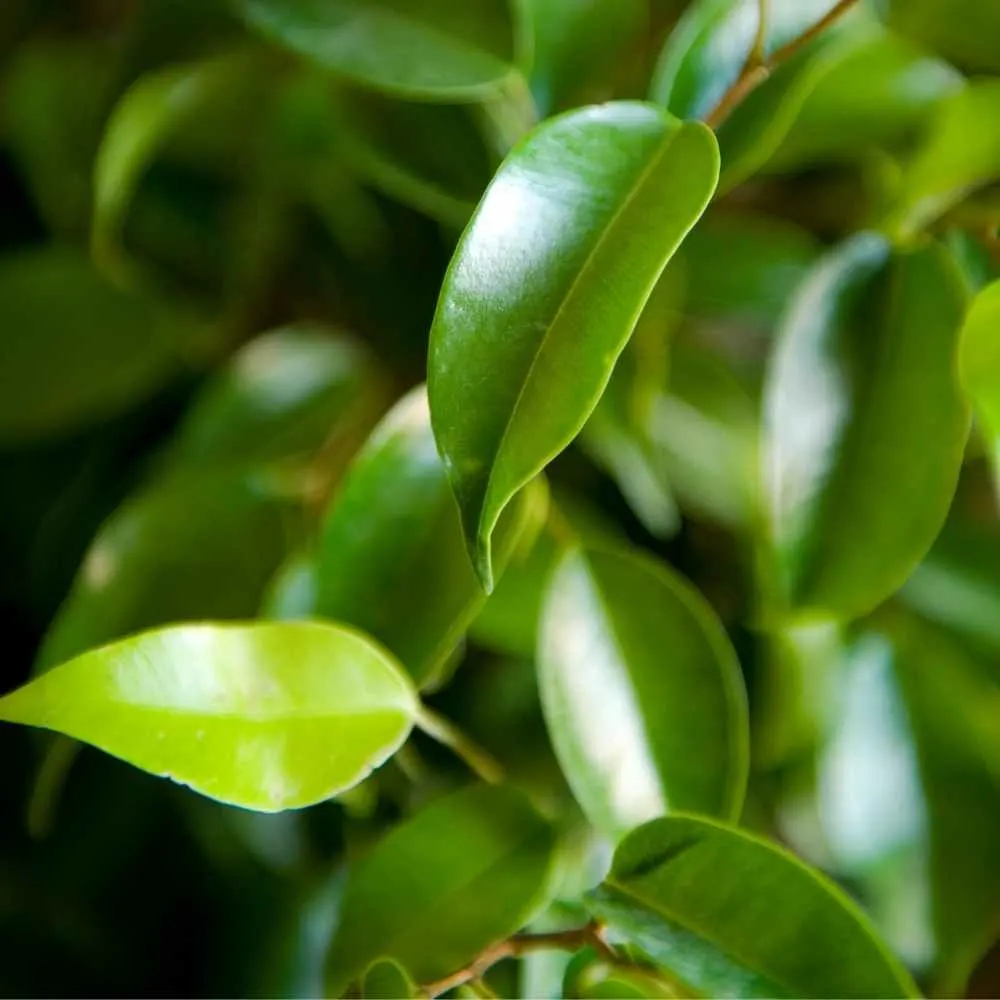
- Weeping figs enjoy occasional leaf washing. Washing the leaves periodically will keep the leaf pores (stomata) open so the plant can properly respire.
- Leaf washing also hydrates the leaf and removes pests that are trying to set up housekeeping on your plant.
- Wash the leaves gently with water and Neem oil on a monthly basis. Neem oil leaf shine will give the leaves a wonderful shine and deter pests.
- Alternately, Milk is also a great leaf washer for adding shine to plant leaves.
- Be sure to wash the leaf top and bottom.
Pests:
- ficus trees need to be checked periodically for pests.
- Stress by longterm overwatering, poor light, extreme temperatures and soil conditions are contributors to plant stress. And makes them more susceptible to pest damage.
- Spider mites, mealy bugs, scale, thrips and whitefly are the most common houseplant pests you will see.
- Read our post on How to get rid of aphids and other pests with our homemade pesticide soap recipe or neems oil.
- To minimize the possibility of pests be sure to check all nursery plants before bringing them home.
- Quarantine all new plants until you are sure no pests live in them.
Ficus Benjamina Propagation:
- Propagation is rather simple. The easiest methods use stem cuttings.
- Water Propagation:
- Take a cutting from a stem that is at least 6 inches long with healthy leaves.
- Place cutting in jar with water, cut side down. Make sure no leaves are in the water.
- Set the jar in well lighted area. Replace the water in the jar every 3 days or so. Root hormone can be used to speed up root growth.
- Roots will form in 3 weeks or so.
- Soil Propagation:
- You can also plant the cut stem directly in moist soil.
- Dip the stem in root hormone gel for faster growth.
- Make sure the soil remains lightly moist until new growth establishes.
- This will take 3 to 6 weeks.
- Air Layering:
- Air layering will also work for weeping fig plant propagation.
- Roots will grow in 6-8 weeks.
- Plant in soil when roots are at least 4 inches long.
Notes
Ficus trees are fairly straightforward to care for. However, there are a few things to look out for with your plant.
Weeping figs are well known to drop leaves often. This is not usually a problem. New growth will quickly replenish the branch.
Some reason for falling leaves:
- If you move the tree it will drop leaves.
- low light increase leaf drop.
- Inconsistent watering will result in leaves yellowing and dropping.
- Old leaves do regularly drop. This is normal. New leaves will grow.
Signs that your Weeping fig Plant is not happy:
Large brown spots on leaves, this can be caused by root rot. If the plant is dropping leaves and the leaves are looking sick, check the roots.
If your Ficus tree has yellowing leaves suspect over watering.
If a weeping fig plant has brown tips on its leaves the air is too dry. misting and a humidifier are needed.
Leaves burned mean plant is in a too hot direct light. Remove to moderate indirect light.
This video for ficus lyrata (fiddle leaf fig) also covers the care needs for your Ficus benjamina.
Related Content:
Follow Us:
Find us on YouTube, Instagram , Pinterest and TikTok! We love to Plant chat. We also comment, like and occasionally share your content to our daily stories. We’d love to see your plants. Share your joy in your houseplants. Happy Planting!
Recent Posts:
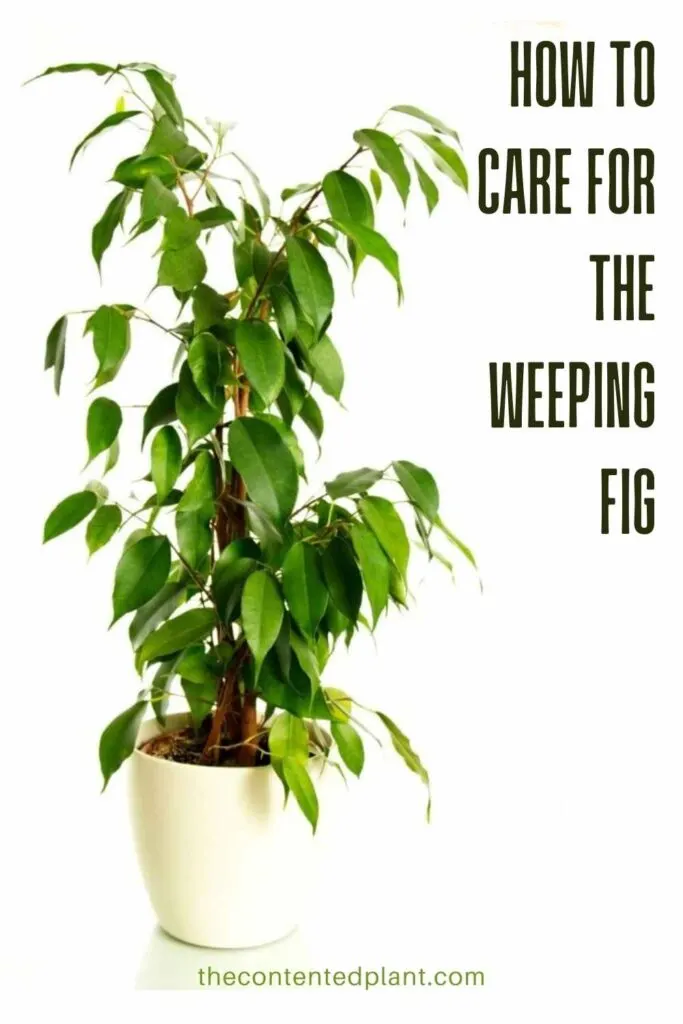

How to Keep your Houseplants Alive In Winter - The Contented Plant
Tuesday 11th of January 2022
[…] plants leaves will help increase humidity. Larger tropical plants like the money tree, Ficus benjamina and Thai Constellation Monsteras can be given occasional showers to clean and hydrate the leaves. […]